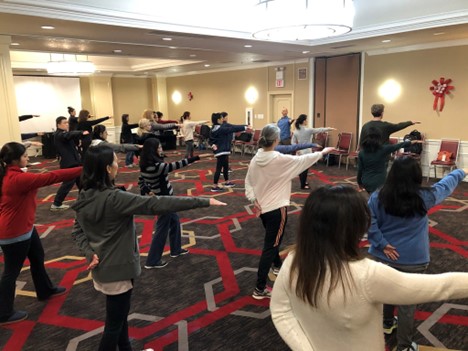Written By: Brian Trzaskos, PT, LMT, CSCS, CMP, MI-C
Is Tai Chi an answer for Clinician overwhelms AND effective client healing?
 It is no secret that health care professionals are feeling more stressed, overwhelmed, and burned out than ever before. A sobering recent survey by Elsevier Health found that by 2025, 47% of current health care workers in the US will be leaving their roles; yes, leaving their roles in health care! If a statistic like that doesn’t spur action to change the current working conditions in health care, I’m not sure what would.
It is no secret that health care professionals are feeling more stressed, overwhelmed, and burned out than ever before. A sobering recent survey by Elsevier Health found that by 2025, 47% of current health care workers in the US will be leaving their roles; yes, leaving their roles in health care! If a statistic like that doesn’t spur action to change the current working conditions in health care, I’m not sure what would.
For well over a decade, I have been advocating for the idea that healthcare professionals can simultaneously practice self-care while treating patients using Rehabilitative Tai Chi.
Strong research has shown that practicing Tai Chi has multiple holistic benefits including improving:
- Balance
- Cardiopulmonary function
- Cardiovascular endurance
- Emotional Well-being
- Depression
- Anxiety
- Chronic Pain
- Lower extremity strength
- Fatigue
- 6-minute walk time
- Quality of life
 One of the most powerful elements of Tai Chi is when people practice together. Perhaps you’ve seen groups of people gathering together in a city park to practice their Tai Chi forms in slow and graceful movements? From a clinical perspective, for 25 years I have enjoyed practicing the Tai Chi principles with my rehabilitation clients so that while my clients show gains in balance and strength, I get to feel more energized and relaxed!
One of the most powerful elements of Tai Chi is when people practice together. Perhaps you’ve seen groups of people gathering together in a city park to practice their Tai Chi forms in slow and graceful movements? From a clinical perspective, for 25 years I have enjoyed practicing the Tai Chi principles with my rehabilitation clients so that while my clients show gains in balance and strength, I get to feel more energized and relaxed!
The mechanisms through which Tai Chi positively impacts mental wellness are still being explored however one of the leading candidates of research has been the autonomic nervous system and more recently the Vagus Nerve. Cranial nerve X (ten), the Vagal nerve complex is the primary conduit of parasympathetic activity between the brain and body. In circumstances of chronic stress and disease, Vagus nerve function or “tone” has been shown to decrease, making recovery from acute stressors or illness more difficult to bounce back from. This contributes to a spiraling down of both mental and physical capacities with the simultaneous loss of the body’s resilience systems. The primary elements of Tai Chi; self-massage, mindful movement, deep breathing, and meditation have all been shown to “tone” or strengthen Vagus nerve function and contribute to improvements in mental well-being.
As rehabilitation professionals, we are continually being asked to do more and only have so much energy to spare. Unfortunately, too often we either become exhausted by the constant demands and burnout or as a protective response, emotionally disconnect from our clients and co-workers making the careers we once loved into an empty daily grind. Learning to practice proven body-mind methods like Tai Chi with our clients offers an effective way to reconnect with the people we care for and even more importantly ourselves. If you are interested in learning more on this topic, register for my upcoming Live Webinar, Rehabilitative Tai Chi for Chronic Back Pain, on November 4th during Summit’s CE Acceleration Virtual Conference.
Explore online continuing education courses from Brian below:
Improving Neck & Shoulder Pain and Dysfunction Using Tai Chi
Integrative Functional Core Strengthening
Rehabilitative Tai Chi for Chronic Pulmonary Conditions
Rehabilitative Tai Chi for Knee and Lower Extremity Pain and Dysfunction
Visit summit-education.com for more information.
References:
Jahnke R, Larkey L, Rogers C, Etnier J, Lin F. A comprehensive review of health benefits of qigong and tai chi. Am J Health Promot. 2010 Jul-Aug;24(6):e1-e25. doi: 10.4278/ajhp.081013-LIT-248. PMID: 20594090; PMCID: PMC3085832.
You Y, Min L, Tang M, Chen Y, Ma X. Bibliometric Evaluation of Global Tai Chi Research from 1980-2020. Int J Environ Res Public Health. 2021 Jun 7;18(11):6150. doi: 10.3390/ijerph18116150. PMID: 34200236; PMCID: PMC8201343.\
Gidron Y, Deschepper R, De Couck M, Thayer JF, Velkeniers B. The Vagus Nerve Can Predict and Possibly Modulate Non-Communicable Chronic Diseases: Introducing a Neuroimmunological Paradigm to Public Health. J Clin Med. 2018 Oct 19;7(10):371. doi: 10.3390/jcm7100371. PMID: 30347734; PMCID: PMC6210465.
